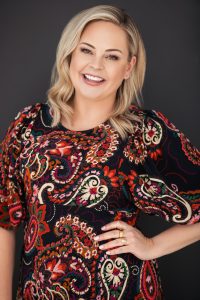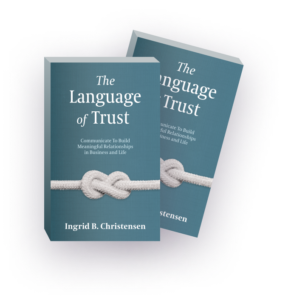Important Components of Trust
Ingrid Christensen makes a big claim: trust can flourish when we find new definitions and names for what we are experiencing, when we discover and learn communication that focuses on maximum precision, honesty and clarity.
She converses about it in her upcoming book, “The Language of Trust.”
“When we don’t carefully choose and define the words we use to communicate, the risk of miscommunication is too high. Careless language destroys trust,” Christensen says.
“By redefining terms like trust and the other emotions it involves, we go through the process of building relationships with those around us. This process gently pushes us toward healing opportunities.
“By refining our words, we invest in the currency of trust with ourselves and others. We build trust and heal the ruptures of trust with language,” she says.
The president and founder of INGCO International, a translation and interpreting services company, Christensen says the inspiration for the book was rooted in her constant thoughts about the concept and behavior of trust.
She had witnessed firsthand, “how translation and interpreting services bridge divides and connect people from different cultures,” she has written.
Christensen details what this looks like.
“Language service professionals serve as witnesses to peoples’ experiences and walk beside them on their journey to access countless necessary life milestones,” she begins.
“Whether helping consumers build secure and meaningful lives, assisting doctors and patients making vital health decisions, facilitating the justice system in the court of law, or allowing world leaders to negotiate, we are at the heart of all communication.
“In doing so, we also serve the clients whose organizations are targeted at helping these end users, the organizations doing this meaningful work,” she says.
This work has given Christensen an up close and personal look at what works when it comes to human connection and agreement.
Trust seems like a finite definition yet it is an umbrella term, she claims, because people define trust as different things.
“When we examine what we actually mean by trust, we uncover a multitude of words like capability, confidence, competence, commitment and creativity,” Christensen states. “All these words fall along the continuum of trust and constitute its building blocks. Without all of them, trust is but a wish, a hope, a dream.”
When what others seek and expect from us is present, a positive outcome is much more likely to happen and usually does.
“When the right building blocks come together at the right time, a beautiful display of mutual reliance and interdependence blooms,” Christensen states.
“Trust, therefore, is the result of our actions to encourage it.”
Helpful questions come into play to guide people towards knowing what is necessary for trust because the “how” must be well understood.
“How do we cultivate capability, confidence, commitment and creativity?” Christensen rhetorically asks, before answering. “By realizing our words matter and developing a dictionary of linguistic tools to communicate what we intend to say, we are investing in the currency of trust.”
She has an analogy to illustrate.
“Expert craftspeople understand the importance of examining their toolbox and ensuring they have the right tools sharpened and ready for use,” she says.
This works with expressing ourselves, especially for important purposes.
“Analyzing our vocabulary and the words we have in our toolbox is much the same. We have the opportunity to examine our words, what they convey, and how we use them to improve the accuracy, efficacy, reliability, and authenticity of our communications.”
What can get forgotten, despite how obvious it might be, is that trust is not static. It’s fluid, continually determined by interactions and experiences.
“Trust has countless meanings and exists on a spectrum rather than an on-off light switch,” Christensen explains.

Christensen had goals for readers of her book.
“I am excited to share my perspectives and to crack open trust, examine its core, and give readers an inside look at how it permeates all businesses,” she says. “This book is a heartfelt business guide to everyone invested in building, managing and maintaining trust-based relationships. It’s also for anyone preserving trust in the face of adversity when language is a barrier to open communication.”
Her promise to readers is that they will learn strategies for “creating authentic, trusting relationships with your stakeholders to communicate successfully in any language,” she says. “You will realize that the more people can feel seen and understood, the more you will open up your organization and yourself to the world.”
Christensen is bold in declaring just how critical trust is in relationships and achieving better outcomes.
“To be successful in any business, you must be able to establish a trusting relationship with your stakeholders,” she says. “By building trust, we can create partnerships that last, employees that stay, and — for those of us in language services — translations that speak to the heart of the reader.”
She knows trusting is not always easy yet she aims to encourage people to do so more.
“Brave trust is trusting when you don’t want to. On the days when you don’t feel like it, even when life has taught you not to trust, I hope this book changes your mind. If you are willing to be vulnerably brave with trust, this book is for you.”

